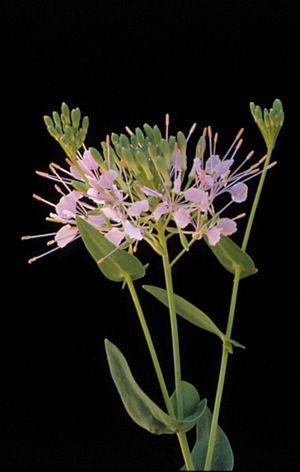Wideleaf pinelandcress facts for kids
Quick facts for kids Wideleaf pinelandcress |
|
|---|---|
 |
|
| Conservation status | |
| Scientific classification | |
| Genus: |
Warea
|
| Species: |
amplexifolia
|
The Warea amplexifolia, also known as wideleaf pinelandcress, is a very rare flowering plant. It belongs to the mustard family. This special plant is found only in Florida in the United States. It grows in just a few counties in the middle part of the state.
Sadly, the wideleaf pinelandcress is in danger. Its home is being lost or damaged. Because of this, the United States government has listed it as an endangered species. This means it needs special protection to survive.
Contents
Meet the Wideleaf Pinelandcress!
The wideleaf pinelandcress is a type of plant that lives for only one year. It can grow to be about 70 to 80 centimeters tall. That's almost as tall as a typical 12-year-old!
What Does it Look Like?
The leaves of this plant have different shapes. But they all share a cool feature: they are "clasping." This means their bases wrap all the way around the stem. It looks like they are giving the stem a hug! Some leaves might even have two small parts that stick out. These leaves can be up to 4 centimeters long.
The flowers grow in a cluster called a raceme. This is a type of flower arrangement where flowers grow along a single stem. The flowers can be white, pink, or even a bit purplish. Each petal is shaped a bit like a spoon. It has a wider, fan-shaped part that narrows down into a very thin stalk.
In the middle of the flower, there are six long parts called stamens. These stamens can be up to 1.5 centimeters long. They stick out far from the flower, making it look unique. After the flowers bloom, the plant produces a thin, narrow fruit. This fruit is called a silique and can be up to 7.5 centimeters long. The wideleaf pinelandcress usually blooms from August through October.
Where Does it Live?
This special plant shares its home with many other endangered species. It lives on the Lake Wales Ridge in Central Florida. You can find it in Lake, Polk, and Osceola Counties.
The wideleaf pinelandcress lives in a place called a sandhill habitat. This is a dry woodland area with sandy soil. It grows best in open, sunny spots. It does not like shade at all! These open areas are usually kept clear by natural wildfires. These fires help remove extra plants and brush.
One of the safest places for this plant is Lake Griffin State Park. In a part of the park, people help keep the area open. They clear away brush and plant native grasses. This helps the wideleaf pinelandcress and other plants grow well.
Why is it Endangered?
The wideleaf pinelandcress faces several big problems that threaten its survival.
Fire and Its Habitat
One major threat is called fire suppression. This means people stop natural wildfires from happening. But the wideleaf pinelandcress actually needs these fires! Fires help clear out old leaves and bigger plants. Without fires, too much plant material builds up. This causes too much shade for the wideleaf pinelandcress, which needs lots of sunlight.
Other Dangers
Another problem is that new plants are moving in. These are called exotic plant species. They are not native to Florida and can take over the space where the wideleaf pinelandcress grows. One example is Natal grass.
The biggest danger is habitat destruction. This happens when land is used for new buildings or farms, like citrus groves. This takes away the plant's natural home. Also, the remaining places where the plant lives are not always taken care of properly. This includes preventing fires, which the plant needs.
Finally, very dry weather, or drought, might also be a threat. The plant seems to grow best when there is plenty of rain. Protecting this plant means protecting its unique habitat and making sure it gets the sunlight and fire it needs.


